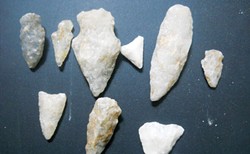It was August and the ripening corn stood taller than we did. The field was bounded by the old Illinois Terminal tracks, South Grand, Cook and the 66 bypass, as it then was still known, Everett Dirksen not having done anything to merit it being renamed in his honor. In that time of year, of course, floodwaters sometimes come down out of the sky rather than rise up from the earth, and for a few hours a deluge had created a torrent surging across that cornfield that was as close to an Amazon tributary as a boy was likely to find on the east side of Springfield. We decided to go exploring.
Wading through the muck along a corridor cleared by the runoff, we found old railroad ties that had been floated a hundred yards from where they’d been dumped. The water had moved a lot of dirt too, and some of it had been hiding a curiously shaped bit of rock.
I don’t recall which one of us spotted it – I think it was Mike. Nor can I recall how we knew that it was an Indian axe head. Eleven-year-old boys are alert to how things work, and even city kids understood that the language of the design, with its groove across the thick end and the tapered blade, announced “axe.” Or maybe I’d seen one like it on one of my many visits to the state museum. In any event, we knew it was Indian, that it was a tool and that it was a lot older than we were.
Curators of the now-defunct Under the Prairie Museum in Elkhart used to remind visitors that a stone axe there on display, which had been found on a nearby farm, would have seemed as strange to that area’s Kickapoo inhabitants in 1800 as it does to us today. Obsidian or flint can hold an edge sharp enough to slice through wood fibers but sandstone can’t. Using one of these to bring down a mature oak tree seems daft. Daft or not, felling trees apparently was one of the things axes like these were used for. In 2000 an industrious curator at the Fruitlands Museum at Harvard University set out to make a dugout canoe using a stone axe much like ours; it took him and his helpers 30 hours to chop down a 36-inch diameter white pine tree. Illinois Indians were still using Stone Age tools when missionaries and traders arrived in this part of the world in the 1670s; the missionaries tried to interest the savages in heaven, but heaven to them was an iron axe, and many a beaver died so they could trade for one. By 1800, the old stone tools were forgotten.
The thing we found was a full-grooved axe, so called because the groove used to lash the axe head to its handle rings the entire stone. I’m told that axes of this type were not ground but reduced to the desired size and shape by pecking the surface with a “hammerstone.” The Indians used a lot of wood for fires and, during some eras, to build stockades to protect their villages. So our axe was, in the end, an instrument of destruction – a war club, if you will, in the human war on trees.
Dealers sell such things today; a good one is worth a few hundred dollars. They’re surprisingly common considering that the Indian population of these parts was not large. In most periods, you could probably crowd all the people living in Illinois’ middle third into the Prairie Capital Convention Center. But while the people were few, the years were many and such tools were in use for a very long time without changing much. (The oldest are several thousands years old.)
Uncountable thousands of artifacts like our axe head have been swept up from places like our cornfield after a rain or a plowing to end up in cigar boxes or glass cabinets. While the most information is gleaned from artifacts found where their makers left them, there is something to be gained by at least knowing where such treasures were found. The Illinois State Archaeological Survey over in Champaign wants to catalog the locations where some of these thousands of spearheads, arrowheads, knives and other chipped stone artifacts were found. That will at least chart the hunting ranges and home territories for dozens of ancient societies across the state.
Lesson? None. I don’t remember what happened to that stone axe. The essential truth of the story – that a cornfield on the edge of town can be, with a little help from nature, a window to long-vanished worlds – strikes me as more magical now than it seemed them. To an 11-year-old kid, the world has an inexhaustible supply of magical things in it, and we quickly moved on to the next one. To a 66-year-old kid, they are harder to come by.
Contact James Krohe Jr. at [email protected].
Stone magic
A trek across a cornfield crosses hundreds of years
[
{
"name": "Air - MedRect Combo - Inline Content 1",
"component": "11490391",
"insertPoint": "3",
"requiredCountToDisplay": "1",
"parentWrapperClass": "fdn-ads-inline-content-block"
},{
"name": "Air - MedRect Combo - Inline Content 2",
"component": "11490392",
"insertPoint": "7",
"requiredCountToDisplay": "5",
"parentWrapperClass": "fdn-ads-inline-content-block"
},{
"name": "Air - MedRect Combo - Inline Content 3",
"component": "11490393",
"insertPoint": "12",
"requiredCountToDisplay": "9",
"parentWrapperClass": "fdn-ads-inline-content-block"
}
]
Illinois Times has provided readers with independent journalism for almost 50 years, from news and politics to arts and culture.
Your support will help cover the costs of editorial content published each week. Without local news organizations, we would be less informed about the issues that affect our community..
Got something to say?
Send a letter to the editor and we'll publish your feedback in print!






















